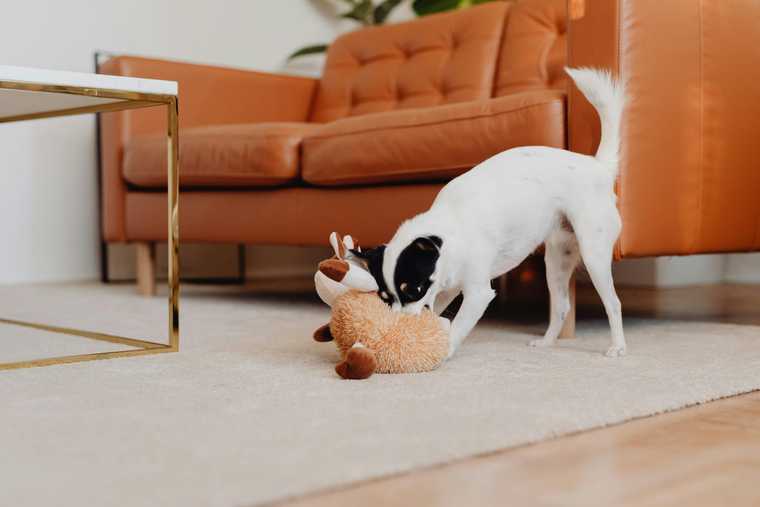Tips for Separation Anxiety in Dogs

Just like their caregivers, dogs aren’t immune to mental health problems. These include not only common fears and phobias but also less pronounced negative feelings and emotions, such as anxiety. Separation anxiety in dogs is normal; all breeds experience it. However, if left untreated, your dog can develop a more severe condition called anxiety disorder.
Want to know what causes separation anxiety in dogs and how to help your fluffy pal overcome it? We will equip you with all the information you need to recognize the signs of separation anxiety in dogs, what you can do to prevent it, and how to help your dog deal with this unpleasant condition.
Armed with practical tips on how to help separation anxiety in dogs, you will assist your pup in learning how to regulate their emotions better and tackle behavioral issues.
Are you interested in learning more about how you can better understand your dog? Woofz is here to help you 24/7! Decode the psychology behind your dog’s behavior and consult professional dog handlers anytime you need.
Signs of Separation Anxiety in Dogs
It’s not always easy to tell whether your doggo deals with separation anxiety while you’re away. Destructive activities caused by separation anxiety in dogs typically occur shortly after an owner’s departure.
Unfortunately, unless pet parents find physical evidence of such behavioral problems, your dog’s anxiety issues may go unnoticed for quite a while.

Separation anxiety in dogs can manifest itself through a variety of symptoms and behaviors that include:
- Excessive vocalization, such as barking and howling
- Urination and defecation from house-trained dogs
- Destructive chewing of objects like furniture or shoes
- Digging at doors, windows, or other exit points
- Increased heartbeat and/or breathing
- Continuous attempts to escape home
- Pacing
What Causes Separation Anxiety in Dogs?
Though it’s still unclear why some dogs develop separation anxiety, we can attribute the offset of the issue to specific life circumstances:
-
Your dog has had a traumatic experience (e.g., life in a shelter, change of owner)
-
You leave your dog home alone for the first time
-
Your dog’s routine has changed dramatically
-
Your dog is over-attached to you
-
Your dog lacks socialization skills
-
You move your dog to an unfamiliar environment, such as a new house
-
You don’t provide enough physical and mental stimulation for your dog
-
Your dog has a genetic predisposition
-
You suffer from anxiety (dogs can pick up on your emotional state and stress about leaving you alone)

How To Fix Separation Anxiety in Dogs?
It’s not only your dog’s mental state that gets affected by separation anxiety. Eventually, the quality of life of the dog's parents decreases, too. Not many owners can choose to stay at home seven days a week to deal with severe separation anxiety in dogs.
Unwanted behavior combined with damage done to the property may get in the way of you forming a strong bond with your pet.
Can separation anxiety in dogs be cured? The solution to your dog’s anxiety problems is to develop well-planned yet cautious methods for handling the issue.
Let’s discuss in more detail what they should include.
Spend more time with your dog
When you modify behavior to treat separation anxiety in dogs, avoid leaving your pet home alone. You may need to make some arrangements regarding your work schedule, choose daycare facilities, or leave your dog with relatives or friends.
You may also start gradually introducing your dog to a crate. It can help isolate your dog and prevent destructiveness. However, you should be careful. Many anxious dogs try to escape the crate, which can lead to self-injury. To prevent this, take it slowly and use the crate first at home in your presence.
Desensitize your departures
Imagine you trained your dog to tolerate your short-term absence well when you stay home. What’s the next step to stopping separation anxiety in dogs? It’s time to desensitize your four-legged pal to your actual absence.
Start with brief departures, with your dog’s reaction monitored by video recording. For example, you leave for 5 minutes, but your pet gets agitated after 3 minutes. This means the time of your absence should be shortened.
Modify the absence time accordingly until you see positive changes in your dog’s level of separation tolerance.
Consider drug therapy
Behavior modification proved effective in helping anxious dogs adapt better. Unfortunately, if you’re facing severe separation anxiety in dogs, it can be insufficient. In this case, you should consider drug therapy, which often includes anxiolytic drugs. Carefully supervised by your vet, It can facilitate and assist behavior modification.
The duration of drug therapy can vary from 4 to 6 months until satisfactory improvement is reached. If your dog requires long-term drug therapy assistance, remember to conduct annual blood and urine checkups to monitor their health.
Don’t use punishment
No matter what unwanted behavior your dog displays, whether chewing, digging, or howling, stay away from punishing them. Remember, these activities are instead a sign of distress rather than your dog’s genuine desire to irritate you. Punishment can only worsen separation anxiety in dogs.
You’re probably familiar with your dog's guilty look when they destroy something in your house. It’s a clear sign of conditioning. Your pet will associate destroyed items with your arrival and subsequent punishment. Next time, the behavior will reoccur the moment you leave.
Thus, punishment doesn’t change your dog’s behavior patterns; it only solidifies them.
Other Home Remedies for Separation Anxiety in Dogs
You can deploy different strategies to ease the symptoms of separation anxiety in dogs. Here are some practical tips on how you can help your dog miss you less:
-
Establish a predictable routine (stick to a consistent schedule of daily feeds, exercise, and departure times)
-
Leave your dog some items that smell like you, for example, your clothes
-
Provide daily mental stimulation, such as interactive toys or entertainment
-
Ask your friend or neighbor to visit your dog while you’re away
-
Keep a healthy exercise schedule
-
Hire a dog walker to provide your pet with extra human interaction
-
Give your pup a special treat or toy when you leave to make being alone a little less "ruff"
-
Grab your keys or put on your coat without actually leaving sometimes. It helps your dog realize that these cues don't always mean you're gone for good.

Leaving your dog home alone for the first time can be challenging. Woofz is ready to help your dog be more independent! Download the app now to learn practical tips from a certified dog trainer.
How To Prevent Separation Anxiety in Dogs?
As with any other disorder, separation anxiety in dogs is more accessible to prevent than treat. We’ve assembled for you a list of practical tips on how you can prevent the development of anxiety issues in your furry companion:
-
Encourage early socialization by introducing your dog to different people and experiences. This improves their adaptability and reduces the risk of separation anxiety in the future
-
Leave your pet alone for short periods daily to help them get used to the idea of you being away
-
Encourage your pet to spend some alone time in a safe environment, such as a crate
-
Stay playful with your dog. Provide your dog with sufficient levels of daily mental and physical stimulation
-
Leave home and return calmly. Don’t interact with your dog for 15 minutes before you go and a few minutes upon your return.
Bottom Line
Dogs are naturally social creatures, which can sometimes make them prone to anxiety issues. Separation anxiety in dogs isn't fun for anyone and can cause a bunch of unwanted behaviors. But don’t give up! Spending quality time with your furry friend helps build a strong bond with healthy boundaries and slowly introduces them to the idea of you being away. If the situation doesn’t improve over time, don't hesitate to seek medical therapy under the guidance of a vet.
We'll get through it together!

Passionate team dedicated to help pet owners raise safe and obedient dogs, fostering meaningful connections with their furry companions.

A certified dog trainer with a background in Behavior Science, Canine psychology, and Pet First Aid Safety